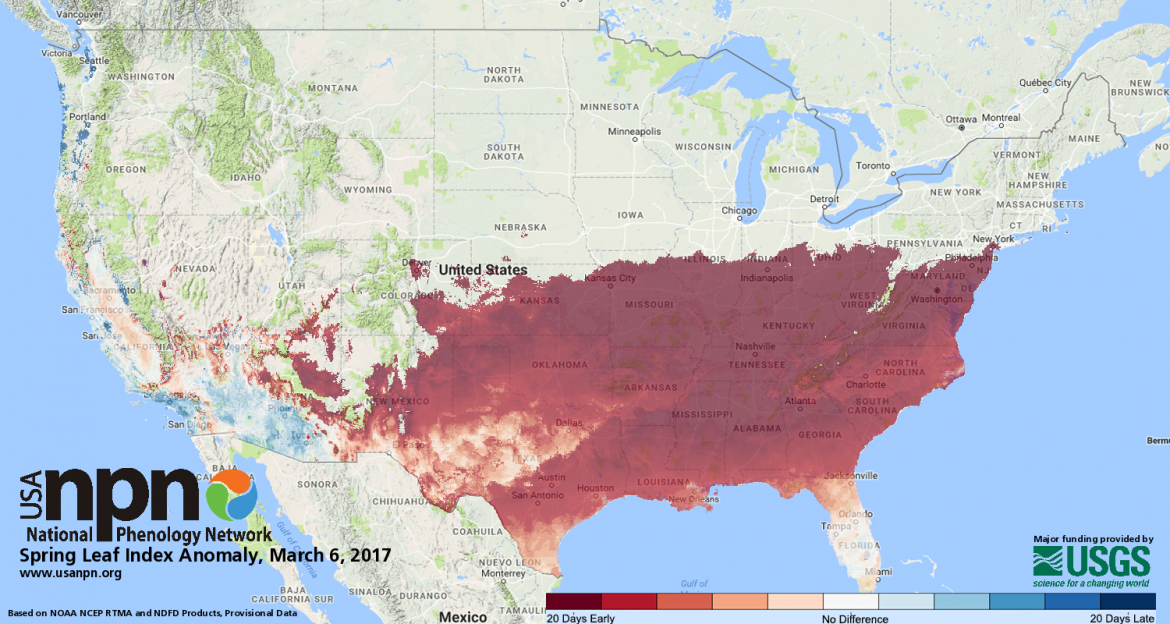
As we walk up and down our neighborhood streets, or commute to and from work, we may notice that some trees have already begun flowering. Daffodils have already made their yellow presence known to people taking leisurely hikes on warm February afternoons. For a brief time, insects hatched and flew through the air, only for this most recent cold spell, and any subsequent cold spells during March and April, to put a halt to their premature flight.
During this past February, we have seen thousands upon thousands of record high temperatures for the month around the continental 48 states. The polar vortex that normally descends from Canada, through the Midwest, and out over the Appalachian Mountains has migrated to the other side of the world this season, now blanketing northern Europe and Russia. Between the 1st and 20th of February, there were 5294 daily high-temperature records broken in the United States, contrasted with 85 low-temperature records broken, for a ratio of 62:1 high/low temperature records. In a normal situation, we’d expect a 1:1 ratio, but February has been warming faster than the other months at +3.1F between 1895 and 2016. At this time of year, the Great Lakes are normally around 42% covered with ice. Currently, ice covers just 8.1% of the Great Lakes. While we enjoy the mildness of 70F days in February, we cannot find ourselves too comfortable with this unusual trend. We may like being able to picnic or play outdoor sports in the winter, but there are a range of other biota that are more severely impacted by the earlier warmth.
Above is a map from the National Phenology Network showing the early leaf budding across the Midwest, Southeast, and Mid Atlantic this past February. Scientists, farmers, gardeners, and citizens who document when plants bud each year are studying phenology, or the study of seasonal events. We have a wealth of documentation going back to the time of Henry David Thoreau in the mid 1800’s. Since the early 1900’s, roughly 2/3rds of the species studied have shifted towards earlier spring blooms, broods, and migrations. Every major species group has noticeably shifted, including birds, fish, amphibians, mammals, invertebrates, trees, non-woody plants, coral, and algae. This trend is not only noticeable in the continental United States, but on every continent and in every ocean, according to Camille Parmesan, a professor at the University of Texas who studies the biological impacts of climate change.
The life that remains dormant through the winter waits for warmer temperatures before awakening, but when the warmth comes ahead of schedule, entire food webs can be thrown off-kilter. Although humans tend to seek warmer climates in the winter months, going on holiday close to the equator to escape the brisk polar air, many species require the seasonal cold in order to successfully go through their life cycles. Many seeds require the winter cold to properly germinate and grow, and many species rest during the cold months to store energy until the abundance of spring. Hibernating and migrating species can become desynchronized with their habitat, using up their stored energy before the ecosystem has time to replenish food supplies. If berries attempt to grow in an early warm period, they become more susceptible to freezing temperatures that can stunt or stop their growth, consequently reducing the amount of berries available during the spring and summer.
As weather is the way that the atmosphere behaves from the minute to month timescale, climate is the long term changes in the averages of daily weather. Occasional false springs have happened throughout history, but recently they’ve been happening more frequently and with a wider variance in daily temperatures. When the temperature changes from 70F to 25F in a matter of days, early buds and blooms can be damaged by the freeze, causing potential failures to flowering and fruiting later in the year. In 2007, after a false spring in the Midwest, Southeast, and Mid Atlantic regions, agricultural crops and deciduous trees were affected so severely that the state of North Carolina requested a disaster declaration because of the money lost from crop damages.
The early budding of trees also affects the flow of sap, nectar, and nutrients within the tree that are sources of sustenance for other organisms. If a false spring disrupts the success of leafing in the spring and summer, then there will be less leaves available to recycle carbon dioxide and to process nutrients, as well as less leaves for insects and animals to consume. This not only affects the organisms that rely on the nutrient recycling of plants for their energy, nor only the plants and trees themselves, but also the health of the soil, which acts as a home for a range of life, from microscopic cells that digest decaying organic matter to small mammals that prey on other soil organisms, such as insects.
While a false spring can negatively affect the local flora and fauna for that year’s spring and summer months, repeated warming over the years has led to mass migrations of species. They are seeking colder climates, moving their inhabited ranges anywhere between 30-995 miles closer to the poles. Some species are ascending in altitude as much as 1300 feet to find comfort in the cold. So as the yearly weather becomes more variable, and false springs become more common, we can observe the changes in climate as they relate to other living organisms. In order to conserve species and ecosystems vulnerable to climate change, we need to see how other species are adjusting to the wider variance in weather patterns.
As humans, we cannot be too comfortable with the warmer weather either. Many people cannot escape their local environment on holiday when it becomes too hot or too cold, and still many more people are tied to their local environment for their livelihoods. Most of the world’s people are farmers, and they have had to deal with the brunt of changing global climates and the subsequent extremes of temperature and moisture. With more variability in day-to-day weather, many farmers are now trying to figure out how to ensure that their crops can survive more extreme temperatures. Some are changing when they plant seeds in the year, while others are attempting to modify the genetics of crops through selective breeding to make them more resilient. The insecurity around food production is testing local, national, and global economies.
While we may enjoy the warm February weather in the short term, we must look at yearly trends and the effects that these warmer winters have had not only upon our local ecosystems, but on our agricultural economies and the livelihoods of the people that rely on crop production where weather is becoming more variable in the extremes. We must prepare not only for variance in temperature and moisture, nor in storm severity or sea levels, but for the effects that these uncertainties have upon local ecologies as well as human infrastructure, whether it be domestic, corporate, or agricultural. We can no longer hibernate all winter in relative seclusion, as we now awaken with the whole world earlier than before.
Further Reading:
https://www.usanpn.org/data/spring
http://www.livescience.com/57992-why-february-is-so-warm.html
https://ensia.com/features/why-you-shouldnt-hope-for-an-early-spring/
http://www.mndaily.com/article/2017/02/climate-change-minnesota
